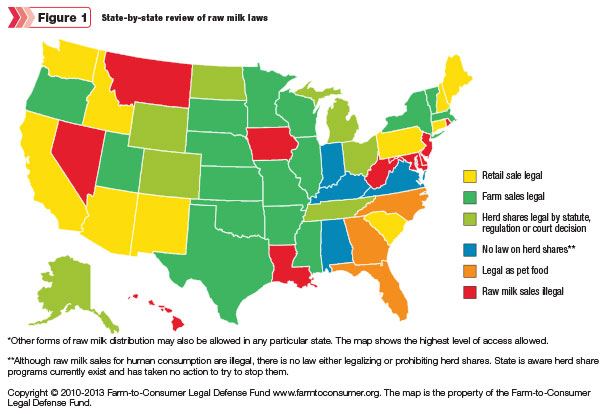The Centers for Disease Control and Prevention recently released a study detailing the number of illness outbreaks associated with non-pasteurized (raw) milk from 2007-2012. The study was published in the January 2015 edition of the Emerging and Infectious Diseases Journal.
The study found that most illness outbreaks (77 percent of the total 81 outbreaks reported) were caused by Campylobacter spp. According to foodsafety.gov, signs and symptoms of campylobacter can include diarrhea, cramps, fever and vomiting.
It may take two to five days for these symptoms to appear after ingesting contaminated products, and symptoms may last from two to 10 days. Other sources besides raw milk can include raw and undercooked poultry and contaminated water.
The 81 outbreaks reported from 26 states resulted in 979 illnesses and 73 hospitalizations, but no deaths were reported. Of the outbreaks, 81 percent were reported from states where raw milk sales are legal.
In 2004, raw milk sales were legal in 22 states. By 2011, that number had increased to 30.
The researchers concluded that as raw milk sales have become legal in more states across the U.S., the number of reported illnesses due to raw milk has also increased.
The National Milk Producers Federation (NMPF) was quick to promote these findings.
“The more raw milk is available to people, the more people become sick,” said Beth Briczinski, NMPF’s vice president for dairy foods and nutrition, in a press release. “Since 2004, eight more states have allowed raw milk sales, and food-borne illnesses associated with raw milk consumption have increased.”
“In the face of these findings,” Briczinski added, “state and federal regulators and legislators must resist pressure from those seeking to make raw milk more accessible.”
Raw milk availability
Figure 1 details the current status of raw milk sales in each state. In more than 20 states across the U.S., raw milk is available in retail stores or at the farm level. For some states like Oregon, raw milk is only legal for goat and sheep milk.

Raw milk legislation varies greatly by state. As demand increases, raw milk consumers and producers work to increase access to the product, according to Pete Kennedy, attorney and president of the Farm-to-Consumer Legal Defense Fund’s board of directors.
One particularly interesting piece of legislation is in the works in South Dakota, Kennedy says. While raw milk on-farm sales are legal in the state, a proposed bill would create a separate set of rules for the sale of raw milk for human consumption.
Currently raw milk producers are subject to rules originally intended for Grade A raw milk that is produced for pasteurization and for manufactured milk, which is used primarily for the production of pasteurized butter and cheese.
“This would be big [for raw milk producers] for the government to recognize that raw milk intended for pasteurization and raw milk intended for human consumption are two separate products,” Kennedy says. “It would lessen the burden on raw milk producers because some of the current regulations shouldn’t apply to what they’re doing.”
The NMPF wrote a letter to the state Senate on Jan. 26, urging them to oppose the bill. An excerpt from the letter said: “No matter how carefully it is produced, raw milk is inherently dangerous. Americans have become ill after consuming raw milk obtained from farms of varying sizes, from cow-share programs and from licensed, permitted or certified raw milk producers …
“Another misleading claim is that testing or regulating the sale of raw milk will protect consumers from the risks of raw milk consumption. This is also unfounded. Product testing is not an adequate substitute and cannot ensure the same level of safety as pasteurization. Legalizing and regulating the sale of raw milk sends a signal to consumers that drinking unpasteurized milk is safe when, in fact, the opposite is true.”
The bill has passed in the South Dakota Senate and is awaiting review in the state House of Representatives.
Kennedy spoke about other legislation efforts during the 2014 Raw Milk Symposium held Nov. 10, 2014, in Indianapolis, Indiana.
“Montana came very close to passing a bill that would have made on-farm raw milk sales legal,” Kennedy told attendees. “The Montana Department of Livestock got involved and wanted a one-size-fits-all regulatory approach, and the bill failed.”
Kennedy says that neighboring states to Montana have favorable raw milk laws, and there is much momentum among producers and consumers. He believes a bill introduced this year has a good chance of passage.
Future of raw milk sales
There is a federal ban on raw milk for human consumption in interstate commerce, but it’s still up to individual states to decide whether or not they will legalize its sale. Individual states are being influenced by federal mandates, though, Kennedy says.
He shared at the symposium that the FDA’s Food Safety Modernization Act (FSMA) could have implications for raw milk producers.
One example is the FSMA’s Hazard Analysis and Risk-Based Preventive Controls program.
“My view is that, much like HAACP [Hazard Analysis and Critical Control Points], it’s a plan that works well on paper but it can be arbitrarily applied by government inspectors,” Kennedy said.
The Pasteurized Milk Ordinance also comes into play. Section 9 of the PMO prohibits the sale of unpasteurized milk to the final consumer. So unless a state has a law specifically legalizing the sale of raw milk and overriding this provision, they’re subject to this rule. Some states have not included section 9 in their adoption of the PMO.
Kennedy regards the FDA as the most anti-raw milk agency in the country. He said an official with FDA stated at a 2013 Illinois hearing that the agency considers all raw milk potentially adulterated. Under the PMO, any adulterated or misbranded milk may be impounded by a regulatory agency.
Additional amendments to the PMO are expected to be made at the 2015 National Conference on Interstate Milk Shipments, to be held April 24-29 in Portland, Oregon.
Despite the ongoing efforts of federal regulatory agencies and dairy industry groups, Kennedy remains hopeful about raw milk’s future and confident in consumer demand.
“I think in another five to 10 years, we’ll see raw milk access in all 50 states,” he said. PD

Emily Caldwell
Editor
Progressive Dairyman




